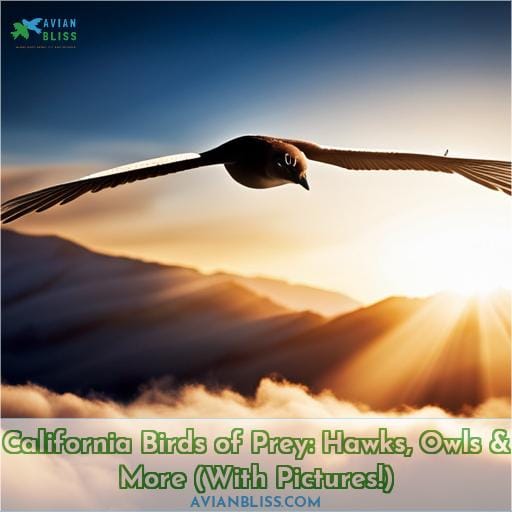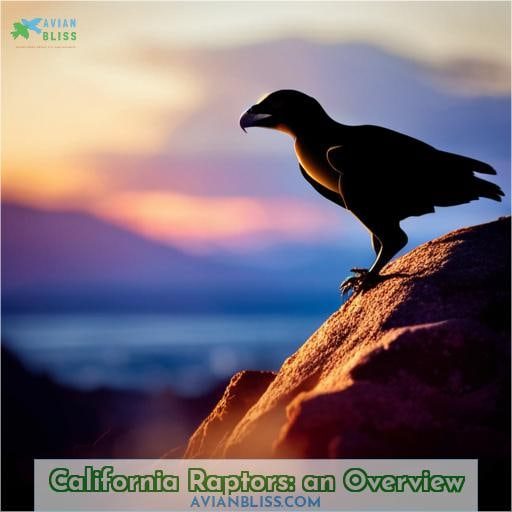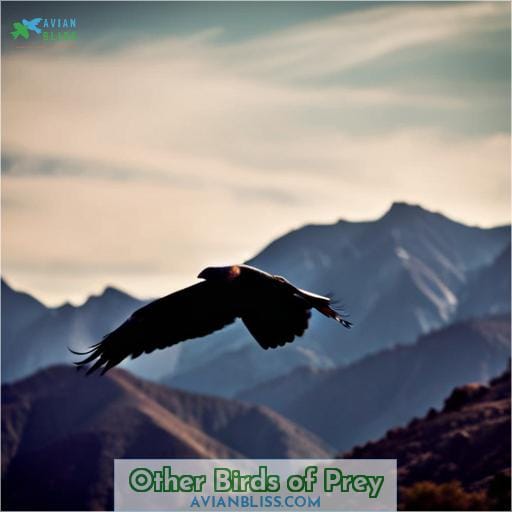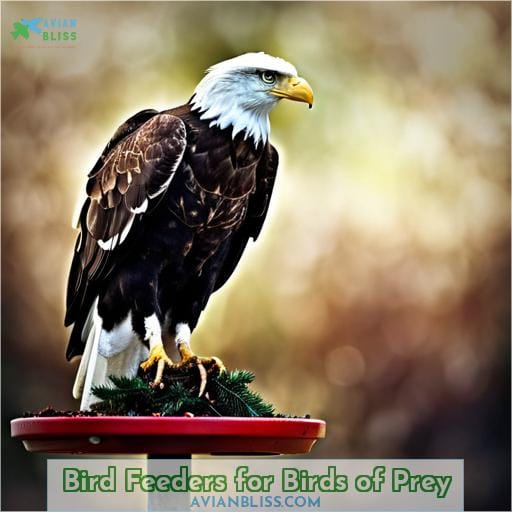This site is supported by our readers. We may earn a commission, at no cost to you, if you purchase through links.
 Do you ever wonder why birds of prey are so popular? It’s not a surprise, given their impressive hunting skills.
Do you ever wonder why birds of prey are so popular? It’s not a surprise, given their impressive hunting skills.
From Red-tailed Hawks and Sharp-shinned Hawks, to Great Horned Owls and Peregrine Falcons, there’s no shortage of amazing birds of prey in this state.
In this article, we’ll take a look at pictures and types of these incredible creatures that call California home. We’ll also discuss laws surrounding them, how best to identify them, common waterbirds found here, and even bird feeders specifically built for our feathered friends.
So let’s dive into learning about California Birds of Prey!
Table Of Contents
- California Raptors: an Overview
- Hawks in California
- Owls in California
- Other Birds of Prey
- Other Birds in California
- Laws About Raptors in California
- How to Identify 8 Hawks in Southern California
- What is the Most Common Hawk in California?
- Does California Have Falcons?
- Bird Feeders for Birds of Prey
- Frequently Asked Questions (FAQs)
- Are there any endangered species of birds of prey in California?
- What is the best time of year to observe birds of prey in California?
- What are the legal implications of hunting birds of prey in California?
- Are there any specific conservation efforts aimed at protecting California birds of prey?
- What is the average life span of a bird of prey in California?
- Conclusion
California Raptors: an Overview
Discover the beauty and strength of California’s raptors as they soar across our skies, hunting prey with their razor-sharp talons. From red-tailed hawks to bald eagles, peregrine falcons to golden eagles and turkey vultures; each species has specific breeding habits, diet requirements, and habitat selection which are integral for successful nesting sites.
Red-tailed hawks require open woodlands or grassland areas for building nests, while bald eagles prefer tall trees near water sources such as lakes or rivers that provide an abundance of food in the form of small fish.
Peregrine falcons have adapted well to urban environments, where they hunt pigeons from atop buildings! Golden eagles favor mountainous regions, while turkey vultures will nest on cliff sides or abandoned buildings when natural structures aren’t available.
Hawks in California
California is home to many different species of hawks, including Red-tailed Hawks, Sharp-shinned Hawks, Cooper’s Hawks, Red-shouldered Hawks, Ferruginous Hawks, Swainson’s Hawks, Rough-legged Hawks, and Ospreys.
These birds of prey have adapted to a variety of habitats and feed on small mammals or fish, depending on the species.
Red-tailed Hawk
Explore the majestic Red-tailed Hawk, a large raptor with red tails found in many habitats throughout California. Breeding habits include four eggs per clutch and both parents providing care for their young until they can fly on their own.
The diet of this hawk mainly consists of small mammals such as mice and voles. They hunt by hovering or “kiting” over grassy lowlands while searching for prey. To identify them, look out for its distinct coloring: white tail/white head/gray body/white underparts/black shoulder patches and orange-red eyes! Conservation efforts have been made to protect these birds from destruction of habitat through management plans that help maintain suitable nesting sites, especially in urban areas where hawks may struggle due to human encroachment on their space needs.
Sharp-shinned Hawk
You can find Sharp-shinned Hawks in urban and suburban areas, snatching up small birds and amphibians with their bluish-gray backs, red chests, and blackish-gray caps. They have powerful tracking abilities to detect prey from above; their diet consists mainly of rodents but they’ll also take songbirds.
Nests are often found near water sources or in thick vegetation. Migration patterns depend on the population size: large populations travel south for winter, while smaller ones stay put year-round.
Cooper’s Hawk
Admire the Cooper’s Hawk, a raptor found in urban and suburban areas that eats songbirds and small mammals with its bluish-gray back, red chest, red-gold eyes, and blackish-gray cap. With a wingspan of around 40 inches, they’re excellent hunters. They generally hunt from perches or by flying close to the ground, using surprise tactics on unsuspecting prey like rabbits and mice.
Their habitat consists of open woodlands, where they build nests high up in trees for breeding season, which usually starts during March/April when migrating hawks return to California from Central America and further south regions.
Red-shouldered Hawk
Marvel at the Red-shouldered Hawk, a raptor with barred rufous chest and white underwings, banded tail, and red shoulders. It prefers to nest in tall trees near water sources. Its diet consists of small mammals such as mice or voles, but it has also been known to feed on snakes and frogs.
During migration, they fly south for winter months, then return north during springtime nesting season after mating pairs have finished caring for their young. Their habitat is mainly woodlands, where they prefer open areas, but they can sometimes be seen perching atop power lines too! The plumage of this hawk is distinctively colored with its black cap, gray wings and back, along with rusty facial markings, while emitting loud calls when flying near its prey or nest site.
Ferruginous Hawk
Experience the majestic Ferruginous Hawks, with two color forms and incredible hunting skills, soaring across California skies. These raptors have a light morph form which is cream-colored with rusty spots on the back and wings.
The dark morph is darker brown overall and has more distinct stripes along its body. They inhabit open spaces such as grasslands or deserts, where their diet preferences of small mammals can be found easily.
However, due to habitat loss, they are now considered an endangered species, requiring conservation efforts from organizations like The Old English Raptor Group (OERG). They usually migrate south during wintertime, while nesting habits involve laying up to four eggs at once in hollow trees or cliff ledges for protection against predators like American Barn Owls, which prefer open nests on flat land surfaces.
Swainson’s Hawk
You can spot Swainson’s Hawks in California from April to August/September, when they migrate to Argentina. Buteo jamaicensis, which are about the size of Peregrine Falcons and slightly larger than Northern Harriers, feature a brownish-gray body with white underparts and barred tail.
Look for them on their nests located in shrubs or small trees near open fields where they feed mainly on voles and mice. Identification tips include yellow eyes similar to Great Gray Owls but without the facial disc; longer wings compared to other hawks; shorter tails than Red-tailed Hawks; and rusty shoulder patches seen during flight displays by breeding pairs.
Conservation efforts are underway due to its declining population despite its wide range across North America.
Rough-legged Hawk
Observe the Rough-legged Hawk, a raptor with feathers down to its feet that hovers while looking for food. This hawk has gray wings and light brown mottled body. It migrates from northern areas in winter and mainly inhabits open grasslands or Mt.
Pinos area. Their diet consists of small mammals like rabbits, voles, mice, falcons, etc. They build their nests on cliffs or trees up to 16 ft above ground level and lay about four eggs per clutch, which are creamy white/brown in color.
The female incubates them while the male hunts and brings food back for the nestlings.
Osprey
Glimpse the osprey, an aerial predator specialized in catching fish near water sources. Its diet consists mostly of fish, but sometimes insects and small mammals are taken too. The osprey has a wide habitat range, from temperate to tropical coasts and inland bodies of water like lakes and rivers, from Alaska to Chile.
They migrate for the winter season, some traveling over 12,000 miles roundtrip! They build huge nests on top of trees or man-made structures like telephone poles or docks, giving them better access for hunting prey nearby.
Owls in California
California is home to a variety of different owl species. From the Great Horned Owl with its orangy face and black and white stripes resembling a tiger, to the Barred Owl with its horizontal stripes of alternating light brown and dark brown on wings, back, and tail; there are many types of owls that can be found in California.
Other common species include Western Screech-Owls, Snowy Owls, Great Gray Owls, American Barn Owls, Burrowing Owls, and Northern Saw-whet Owls.
Great Horned Owl
Marvel at the majestic Great Horned Owl, with its orangey face and black-and-white stripes resembling a tiger, tufts of feathers on its head like ears. They are unthreatened and can be found in many areas of California. With a wingspan measuring 20 to 25 inches, they are larger than most other owls in this region.
The Great Horned Owl has an alarm call that is loud and harsh, making it easy to identify them from other species such as Barred Owls or Black Vultures, who also inhabit the same area but have different calls.
Their diet consists mainly of rabbits, rodents, reptiles, amphibians, birds (up to the size of hawks) and even skunks! In contrast to the Barred Owl, which usually hunts during night time hours, these predators prefer daylight hunting periods.
Barred Owl
You can spot the Barred Owl with its distinctive horizontal stripes of light brown and dark brown on wings, back, and tail. This nocturnal species prefers to inhabit woodlands with a mix of mature trees as well as open areas like prairies; they hunt for mice in both.
Their behavior is unique – they mimic other birds’ calls to attract prey or confuse predators. Identification is made easier by the heart-shaped face and sandy coloration contrasted against darker hues around eyes and beak.
Western Screech-owl
Experience the beauty of Western Screech-owls, a nocturnal species with horizontal stripes of alternating light brown and dark brown on wings, back, and tail – doesn’t it get any more majestic? With a body length of 7.
5 to 10 inches and wingspan ranging from 22 to 24 inches, they are smaller than other owls like White-tailed Kites or Harris’s Hawks, but no less impressive. Their diet consists mainly of insects, as well as small mammals such as voles or mice, which can be found near their nesting sites, usually located in cavities within trees.
Snowy Owl
Discover the Snowy Owl – a magnificent species of raptor up to 25.2 inches tall and with a wingspan of 48-60 inches that is predominantly white with alternating light and dark stripes! This owl is often found in prairies, tundra, boreal forests, and other open landscapes.
Its diet consists mainly of small rodents such as lemmings or voles, but can also include birds like ducks or geese when available. These owls nest on the ground in dense vegetation near water sources, where they lay four eggs per clutch which are creamy white/brown colored.
They use their powerful talons for hunting strategies, including soaring high above fields looking for prey before swooping down quickly to capture it upon sight! The variations in color depend on its habitat; northern snowy owls tend towards all white, while southern snowy owls will have more speckled feathers mixed throughout, giving them an entirely different look than their northern cousins.
Great Gray Owl
Take a peek at the majestic great gray owl, its body covered in gray with alternating light and dark stripes. It sports yellow eyes, a long wingspan of 5ft., and weighs up to 33oz. Breeding season for this species is typically from March-April, with an average clutch size of 4 eggs.
Its diet consists mainly of mice/voles, as well as other small mammals like rabbits or squirrels, making it a fierce predator in California’s forests! Don’t confuse it with northern saw-whet owls, which have similar coloring but smaller bodies – only 6-9 inches tall – they’re easily distinguished by their heart-shaped faces and sandy coloration on wings and back.
American Barn Owl
Appreciate the beauty of American Barn Owls, with their heart-shaped faces and sandy coloring featuring a dark brown edge. Breeding typically occurs between February and July in open fields or grassy areas for nesting.
They usually lay four creamy white to brown eggs per clutch that the female incubates while the male brings food. Their diet consists mainly of small rodents like mice and voles, which they hunt from low perches using their exceptional vision at night.
The habitat requirements are simple: plenty of prey, trees for roosting, and nest boxes installed by humans can all be suitable homes for barn owls to raise their young successfully.
Burrowing Owl
You can spot the Burrowing Owl, with its tawny-brown mottled coloring and short stature, in grasslands or marshes across California. They usually nest underground but have been known to inhabit man-made structures too.
Their diet consists of small rodents such as mice and voles, insects like beetles and crickets, reptiles like lizards and snakes, amphibians like frogs and toads; they also eat plant material occasionally.
Burrowing Owls are usually solitary birds that defend their territory from others of their kind – especially during mating season when males tend to be more aggressive. Conservation efforts for this species include habitat protection through various acts, ensuring they’ll have enough safe spaces for nesting free from human interference for years to come.
Harris’s hawk has recently been introduced into some parts of California where burrowing owl populations were declining due to the presence of other larger raptors (Short-eared owls and Spotted owls) competing for food sources and space in an ecosystem already struggling due to Rough-legged hawks hunting them mercilessly.
Northern Saw-whet Owl
Admire the Northern Saw-whet Owl with its small size, pale browns and tans coloring, and wingspan of 16.5 – 22.2 inches! This owl is found in a variety of habitats, from forests to farmlands, usually near water sources or wetlands.
It feeds mainly on mice, but also eats other small animals like voles and insects, as well as fruits such as berries. In summer, it migrates northward, while in winter it moves southward for warmer climates; this migration can take them across both Canada and Mexico’s borders! Its feathers are soft yet dense, providing insulation against cold temperatures during these journeys too! With its white head, yellow eyes, and barred tail feathers, the Northern Saw-whet Owl is an impressive bird to behold.
Short-eared Owl
The Short-eared Owl is a medium-sized owl with tawny-brown mottled feathers and a wingspan of 33.5 to 40.5 inches. It’s found in California searching for food while hovering or gliding low above the ground.
Its diet consists mainly of rodents, but it will also feed on small birds such as swallows and quail. Nesting takes place in early spring, usually on the ground. Migration occurs annually between August/September and March/April.
Its behavior includes vocalizations that range from soft whistles to harsh screeches. Identification involves looking for its black eyespots near its bill and white eyebrow stripes above them, along with yellow legs and feet.
It prefers open habitats such as grasslands, where it can be seen hunting alongside Harris’s Hawk or Barn Owls.
Other Birds of Prey
Discover the majestic birds of prey in California, such as Peregrine Falcons, Bald Eagles, Turkey Vultures, and Black Vultures. These incredible raptors inhabit many different areas and have unique features that can be admired by observers.
Peregrine Falcon
Witness the amazing power of a peregrine falcon as it soars across the sky with remarkable speed and agility. A bird of prey, this masterful hunter can reach speeds up to 200 mph and dive at 240 mph! Its diet consists mainly of small birds like pigeons or doves, but also includes insects, bats, and sometimes even other raptors.
Peregrines are found in most habitats around the world, from urban areas to open fields or mountains. On average, they measure 15-19 inches tall with an impressive wingspan ranging between 39-43 inches, while weighing 1.
5-3.5 lbs respectively. When nesting season comes around, these majestic birds take refuge on cliff faces or buildings, where they lay four creamy white eggs per clutch before incubation begins by taking turns hunting for food.
The sound of a peregrine is unique yet familiar; usually described as a harsh scream that echoes through its habitat, making them one of nature’s most iconic predators.
| Falcon Speed | Falcon Diet | Falcon Habitat |
|---|---|---|
| 200mph | Small Birds Urban/Open Fields/Mountains |
Bald Eagle
You can spot the majestic bald eagle with its white feathers covering its entire face and distinctive whistles soaring through California skies. Its wingspan of 72-90 inches is truly impressive, as if it were an immense flag billowing in the wind.
Breeding habits typically involve large bodies of water or arctic tundra, where prey identification and nest locations are easily identified. Conservation efforts have been implemented to ensure their protection – primarily diet diversity consisting mainly of songbirds but also fish, rabbits, or other small mammals when available.
Turkey Vulture
Experience the awe-inspiring sight of a Turkey Vulture soaring above with its silver feathers on the underside of its wings. The Turkey Vulture is primarily found in North and South America, but may migrate to Central America depending on food availability.
They mainly feed on carrion, small rodents, and reptiles. They are also known for their characteristic call, which sounds like keeerr. During nesting season, they usually build nests in abandoned buildings or any other sheltered area near food sources such as marshes and meadows.
Black Vulture
The Black Vulture, a short and compact bird of prey with black-colored heads and silver feathers on the underside of its wings, can be seen in California soaring through the sky. But do you know what else it feeds on? This species mainly eats carrion but will also scavenge for eggs or chicks from other birds’ nests.
They have an excellent sense of smell, which helps them find their food sources quickly. They’re sometimes falsely accused of being gray whisltes due to their coloration when flying overhead! Their habitat range is primarily open woods/savannahs, but they may also nest in man-made structures such as barns or silos if necessary.
Conservation efforts for this species include reducing lead poisoning from discarded ammunition, protecting nesting sites, and providing roosting areas away from human disturbance.
Other Birds in California
Aside from birds of prey, California is home to a variety of water and common waterbirds. Ducks, herons, loons, and other aquatic species are commonly found in the wetlands throughout the state, while other species such as ducks, herons, and loons can often be seen in urban areas.
Water Birds
Discover the beauty of water birds in California, such as ducks, herons, and loons. Waterfowl like Mallards are abundant in wetlands while Great Blue Herons can be seen wading through shallow rivers hunting for fish.
Loons use their sharp beaks to pluck small creatures from the depths of lakes and ponds, while both parents take turns caring for nestlings. Migration routes vary between species; some fly south during winter months seeking warmer climates, while others remain in California year-round, feasting on rabbits or deer found near grasslands.
Common Water Birds
Glimpse the beauty of common water birds such as ducks, herons, and loons as they soar across California’s skies. From burrowing owls to short-eared owls, there’s a wide variety of species found in many habitats, including grasslands, marshes, and wooded areas.
Breeding habits vary by species, but typically include four eggs per clutch. Diet types mainly consist of rodents, like rabbits or prairie dogs. Migration patterns are determined by seasonality, while identification tips can be easily identified through their unique coloring and size differences between males and females.
Laws About Raptors in California
You may be familiar with California’s raptors, but have you heard about the laws that protect them? Federal and state regulations are in place to ensure their population size is maintained and protected.
A variety of species such as red-tailed hawks, great horned owls, ferruginous hawks, burrowing owls, short-eared owls, and northern goshawks call this area home. These birds require specific habitat needs like open areas for hunting small mammals such as mice or rabbits.
Violating these laws can result in serious legal repercussions, including fines up to $1 million dollars, depending on each case.
How to Identify 8 Hawks in Southern California
Take a closer look at the eight hawks of Southern California and you’ll be amazed. Cooper’s Hawks, Sharp-shinned Hawks, Northern Goshawks, Northern Harriers, White-tailed Kites – these birds of prey can all be seen in Los Angeles’ residential areas.
Coopers’ Hawk has an average wingspan of 39–43 inches and is found mainly in urban/suburban areas; they eat small songbirds and mammals.
Sharp-shinned Hawks have a wingspan ranging between 18–22 inches; they migrate from Canada during winter and feed on amphibians as well as small birds or mammals.
The largest hawk is the Goshawk with an impressive wingspan up to 4 feet long! They prefer old growth pine forests like Mt Pinos area but will also hunt squirrels or rabbits if needed for food.
Northern Harriers are smaller than most other hawks listed here (with only 16 – 22 inch wingspan). They frequent grasslands and marshes, using their quick speed to catch mice and voles over ground level terrain.
White-tailed Kites come with a different color palette: white tail and head, gray body with black shoulder patches, and orange-red eyes. They are easily distinguishable from other birds in their family. They prefer lowland grassy fields, where they can find rodents for food.
All 8 species lay eggs, averaging 4 per clutch, usually having creamy white or brown colors depending on their type.
In conclusion, there are many amazing raptors that call SoCal home. Each offers something unique when it comes to adapting to predators and finding food sources in our local environment, whether through scavenging or hunting techniques.
What is the Most Common Hawk in California?
Discover the most commonly seen hawk in California, the Red-tailed Hawk. This large raptor is highly adaptable and can be found in many habitats throughout Southern California. It has a red tail that makes it easily distinguishable from other species of hawks.
Its diet consists mainly of small mammals such as mice and voles, but it will also eat reptiles, amphibians, and sometimes even owls if given the opportunity.
The Red-tailed Hawk’s preferred habitat is open grasslands with trees or shrubs for nesting purposes – they build their nests high up on tree branches or cliff ledges to protect themselves from potential predators below.
Their migration patterns are determined by available food sources; they tend to travel south during winter when prey becomes scarce in northern regions, but return north again once conditions improve elsewhere in spring.
They have intricate courtship rituals involving calling out to one another at great heights while soaring above treetops before mating finally takes place towards late summer each year.
Does California Have Falcons?
Yes, California has falcons such as the Peregrine and Bald Eagles. The Peregrine Falcon is known for being the fastest animal on earth, reaching speeds of up to 200 mph. It has a body length of 15-19 inches, a wingspan of 39-43 inches, and weighs between 1.
5 and 3.5 pounds. The Bald Eagle is 30-34 inches in length, with a wingspan of 72-90 inches and weighs 6 ½ – 14 lbs., making it one of North America’s largest birds of prey. Both species build nests from sticks lined with grasses or moss high up in tall trees near bodies of water or riverbanks.
They feed mainly on fish, but occasionally other small animals like reptiles or ducks when available. To ensure their conservation, California Fish & Game Code Sections 3503/3503&3513, as well as CCR Title 14 Sections 251/652/783 through 786&6, limit hunting activities along riversides so these beautiful creatures may continue to thrive in our state forevermore.
Bird Feeders for Birds of Prey
You can provide a unique opportunity for your feathered friends by setting up bird feeders specifically designed for birds of prey. Many common California birds of prey, such as Cooper’s hawks, Sharp-shinned hawks, Northern Goshawks, and White-tailed Kites, are attracted to the right food sources.
Here’s how you can get started:
Understand their diet – Hawks generally eat small mammals like mice and voles. You may also want to offer other small critters they normally find in nature.
Choose the right type of feeder – Place an open platform or ground-level tray near trees or shrubs so predators have a place to perch while feeding.
Use appropriate bait – Prey items should be no larger than 3 inches long with less fur/feathers than typical backyard bird seed mixes.
Provide fresh water daily – Keep clean bowls full at all times so raptors don’t have to search far away from your yard.
Check regularly – Change out spoiled food every few days and keep watch on more aggressive species that ward off competitors easily. Feeding birds of prey allows them access to essential nutrients without having to hunt too far from home, making it easier for them to raise young successfully each season.
Frequently Asked Questions (FAQs)
Are there any endangered species of birds of prey in California?
Yes, California is home to some endangered species of birds of prey, such as the Bald Eagle, Peregrine Falcon, and California Condor.
What is the best time of year to observe birds of prey in California?
Spot majestic birds of prey in California from April to September – soaring red-tailed hawks, swooping ospreys, and awe-inspiring peregrine falcons.
What are the legal implications of hunting birds of prey in California?
Hunting birds of prey in California is illegal and punishable by law. Ignorance won’t exempt you from the consequences, so research before engaging! Appealing to nature’s beauty with powerful imagery will encourage respect for wildlife – a must for all Californians.
Are there any specific conservation efforts aimed at protecting California birds of prey?
Yes, conservation efforts are in place to protect California’s birds of prey. Several state laws safeguard raptors from hunting and other threats, while organizations like Audubon work to restore habitats for species like the bald eagle and peregrine falcon.
What is the average life span of a bird of prey in California?
The average lifespan of a bird of prey is approximately 12-15 years, although some can live much longer. A fitting metaphor for their longevity: the birds soar like eagles, far exceeding the limits faced by other species.
Conclusion
From the majestic Bald Eagles soaring through the air to the tiny Burrowing Owls nesting in the ground, California is home to a wide variety of birds of prey. Whether you’re looking for a large raptor like a Red-tailed Hawk or a small owl like the Northern Saw-whet, you’re sure to find something that captivates you in the Golden State.
Not only are these raptors beautiful to watch, but they’re also essential to the California ecosystem. With its strict laws to protect these birds of prey, California is a safe haven for these magnificent creatures.
So if you’re ever in the area, take a moment to observe the birds of prey and appreciate the beauty and power of nature.













